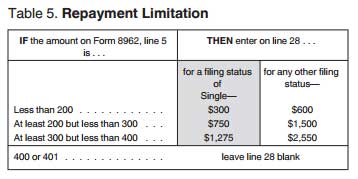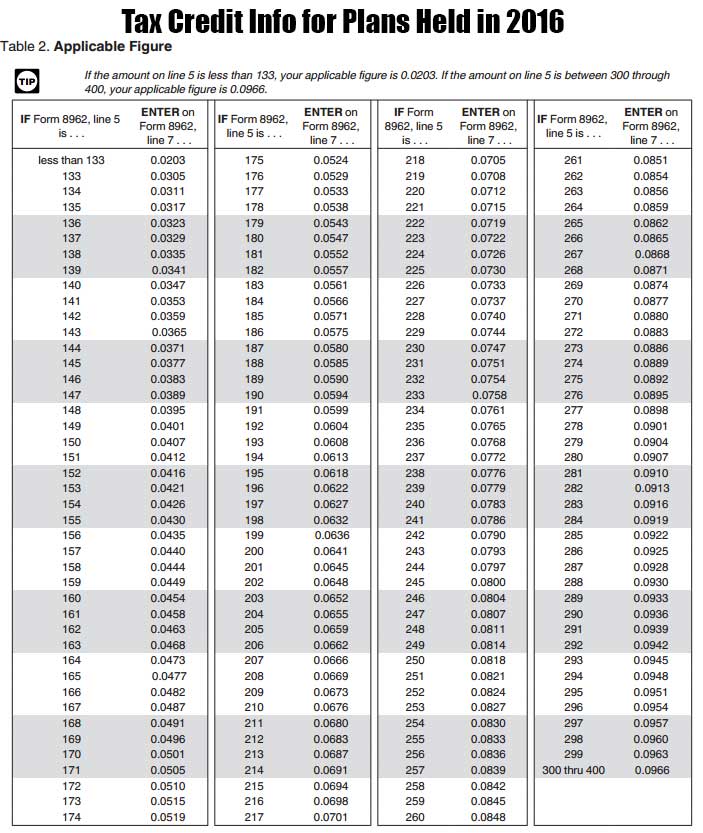2018 Premium Tax Credits







2018 Premium Tax Credits Under the Affordable Care Act (ObamaCare)
We explain how Premium Tax Credits work on 2018 health plans under the Affordable Care Act (ObamaCare). Tax credits can be taken in advance, or at tax time.
In other words, ObamaCare’s Premium Tax Credits (PTC) can be paid to your insurer in advance as Advanced Premium Tax Credits (APTC) to lower your monthly premium on a Marketplace plan. Or they can be taken on your tax returns in retrospect (for example, you can take credits for 2018 plans when you file your April 2019 taxes).
Tax Credits are based on household income and available to folks making between 100% and 400% of the Federal Poverty Level FPL (between $12,060 – $48,240 for an individual and between $24,600 – $98,400 for a family of 4 in 2018; numbers change each year as the poverty level is adjusted). Different guidelines apply to Alaska and Hawaii.
How to get plans that qualify for tax credits: Tax credits are only offered on plans sold on the health insurance marketplace (the federal marketplace HealthCare.Gov or your state marketplace). With that in mind, qualified private heath insurance brokers and agents can help you enroll in a marketplace plan. So you do need a marketplace plan, but you don’t have to go directly through the marketplace if for example you want to sit down with a local in-person insurance agent who is qualified to sell plans sold on the marketplace.
TIP: Plans obtained during open enrollment 2018 (where 2018 health plans are sold from Nov 1 – Dec 15 2017) use the 2017 Federal Poverty Level (FPL) Guidelines to determine cost assistance. Plans obtained through special enrollment in 2018 also use the 2017 FPL guidelines. If you want to take tax credits in advance, you’ll be comparing your projected income to those poverty levels.
FACT: Advanced Premium Tax Credits can lower what you pay to your insurer each month, while Cost Sharing Reduction subsidies can lower the out-of-pocket costs of Silver plans.
How ObamaCare’s Tax Credits Work
Tax credits are based on income and cap your monthly premium between roughly 2% and 9.5% (this number adjusts each year, for 2018 plans the number is adjusted downwards from last year and is 2.01% – 9.56%; see form 8962 instructions for the current numbers) of your total house hold Modified Adjusted Gross Income (MAGI) per household member.
Caps are based on the second lowest cost Silver plan (SLCSP). The less income you have the lower the percentage of your income you will pay within that range. Subsidy amounts are also determined by an plans base premium compared to the SLCSP.
If your income changes slightly, then the exact amount of assistance you will qualify for will too. This could result in you being owed extra tax credits at the end of the year, or owing back tax credits. See tax credit repayment levels (and make sure to update the marketplace if your income or family size changes)!
Each level of the Federal poverty line between 133% – 300% equals a different Tax Credit amount (100 – 133 is about .2%, 300 -400 is about 9.5%; adjusted each year).
It’s up to you to decide what percentage of that Tax Credit you want to be paid to your insurer in Advance. With that in mind, one might considering only taking part of the tax credit up front to avoid potential repayment due to changes to income or family size.
TIP: Only citizens who don’t have access to affordable employer coverage qualify for tax credits based on income on marketplace plans. Tax credits are offered on all metal tier plans, but they aren’t offered on plans not sold on the federal or state marketplaces (i.e. HealthCare.Gov or your states marketplace).
TIP: To get tax credits enroll via HealthCare.Gov or your state’s marketplace, or pick a qualified private broker outside of the marketplace who can help you enroll in a marketplace plan.
Learn more about the Federal Poverty Level here
Learn more about calculating MAGI and calculating tax credits.
TIP: If you think you might go over 400% of the poverty level consider not taking credits in advance, if you think you’ll go under, consider that you won’t be able to take credits in retrospect if you do! Simply, be mindful of the subsidy cliffs.
The Premium Tax Credit Subsidy Caps By Percentage of Household Income for SLCSP
Premium tax credits are based on the second lowest silver plan (SLCSP) in a state’s Marketplace. The chart below shows the minimum and maximum percentage of the household income that a person will pay for that plan. The amount you’ll pay is based on your household income (compared to the federal poverty level) and is adjusted based on the price of the plan chosen.
Keeping in mind that the exact numbers are subject to change each year, the 2018 rates (subsidy caps of the SLCSP for 2018 coverage) are shown in IRS Bulletin 2017-36 and are (remember these adjust each year):[1]
|
Household income percentage of Federal poverty line: |
Initial percentage |
Final percentage |
|
Less than 133% |
2.01% |
2.01% |
|
At least 133% but less than 150% |
3.02% |
4.03% |
|
At least 150% but less than 200% |
4.03% |
6.34% |
|
At least 200% but less than 250% |
6.34% |
8.10% |
|
At least 250% but less than 300% |
8.10% |
9.56% |
|
At least 300% but not more than 400% |
9.56% |
9.56% |
NOTE: To qualify for tax credits you must make between 100% – 400% of the poverty level (FPL). If your state expanded Medicaid you will be eligible for Medicaid instead of tax credits below 133% (or 138% adjusted) FPL.
Advanced Premium Tax Credits
A tax credit can be paid in advanced to your insurer through the Marketplace. This is called an Advanced Premium Tax Credit. The amount paid to the insurer is the difference between your premium cap and the cost of the plan. You’ll see that number reflected when you compare marketplace plans.
NOTE: You can also choose to take only part of the tax credit in advance, or none of the tax credit in advance, and simply deduct the tax credit on your tax returns. If your unsure of your income this is the safest bet, even though it’s less fun than saving money up front.
FACT: ACA Premium Tax Credits (PTC) have replaced HCTC (HealthCare Tax Credits) since 2013.
Reporting Life Changes for Cost Assistance
Be aware that you should report your income if it changes, or if you have another life change that could affect what premiums you get. If you report life changes the marketplace can adjust your tax credit for you, if not you may end up owing money or being owed money on your tax returns.
NOTE: Tax credits can be paid in advance to lower your premium upfront or can be deducted from your Federal income taxes at the end of the year. If you didn’t take the full Tax Credit in advance, or you made less than you projected in 2014 and didn’t adjust your info in the marketplace, you can deduct the remaining amount on your Federal Income Taxes using Form 8962, Premium Tax Credit (PTC).
See our ObamaCare Facts simplified instructions for Form 8962, Premium Tax Credit (PTC).
Who is Eligible For Tax Credits
You are eligible for a Tax Credit if:
- You shop through the Health insurance Marketplace
- Your income is between 100%-400% FPL
- Your not eligible for other coverage like employer based coverage (this is true even if you are a dependent and a family member offered coverage through another members plan)
- You aren’t using Married Filing Separately Status
Sign up for your state’s Marketplace today and find out if you qualify for lower cost premiums with Premium Tax Credits.
Paying Back Advanced Tax Credit Payments or Getting a Refund
If you got Tax Credits you’ll have to adjust them on your Tax Returns to find your Net Credit. Chances are that you will be owed a bigger Tax Refund, or you will owe a portion of those Tax Credits back up to the limitation amount based on income. You’ll need to fill out Form 8962, Premium Tax Credit (PTC) to adjust tax credits, click that link for a simplified guide to filing the 8962 form.
Line 28. Repayment Limitation for 2016 (meant as an example; amounts may adjust each year). The amount you would have to repay due to excess Advanced Tax Credit Payments is limited according to income ensuring you can’t owe more than you can afford.
| Income % of FPL | Filing Status: Single |
Filing Status: All Other |
|---|---|---|
| Less than 200% FPL | $300 | $600 |
| At least 200% FPL but less than 300% |
$750 | $1,500 |
| At least 300% FPL but less than 400% |
$1,275 | $2,500 |
| If your year end income exceeds 400% FPL, you will have to return the total amount of Advanced Premium Tax Credits you received. | ||
See the following two images from form 8962 for a better understanding of where the above numbers are coming from.

The repayment limits for advanced tax credits for 2016 plans. Figures subject to change slightly each year.
TIP: The following image is from the 8962 form for plans held in 2016. It is meant as an example, tax forms that relate to 2018 health plans aren’t published until early 2018.

Table 2. Applicable figures from the 8962 instructions for premium tax credits. This shows how tax credits are calculated for plans held in 2016. This is subject to change each year.